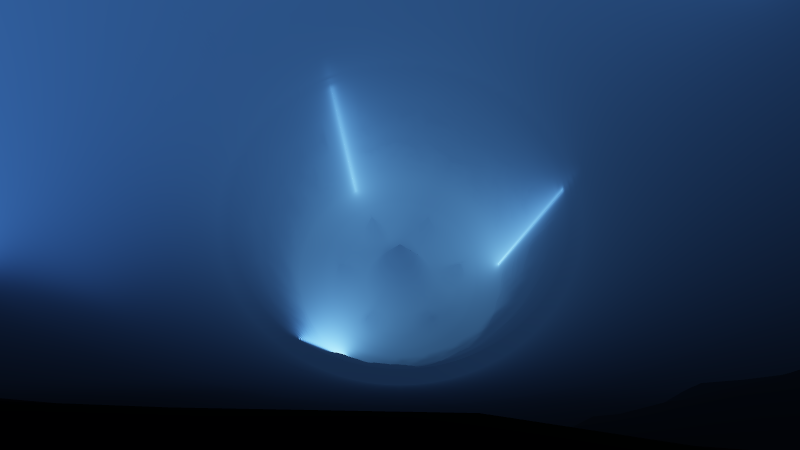
Atmospheric scattering
 |
Rama
physically-based lighting Atmospheric scattering |
Consider a linear light centered at $\bs$, of normal $\bn_s$, of width $w$ and length $2l$ and emitting a radiance $L_0$ in all directions of the upper $\bn_s$ hemisphere. We want to compute the light emitted by this source which is scattered by the atmosphere towards the camera $\bc$, along a view-ray from $\bc$ to a surface element $\bp$ (see Fig. 1).
For a small segment centered at $\bq$ along the path from $\bc$ to $\bp$, the light which is scattered from a light source element centered at $\bs(x)$ towards the camera is the product of several terms:
Finally this product must be integrated over the light source elements $\bs(x)$ and over the path segments $\bq$. The resulting equation is \begin{equation} L_{LVE}(\bc,\bp)=\int_\bc^\bp\mathfrak{t}(\bc,\bq)k_s(\bq)\int_{-l}^{+l}P\left(\bs(x)-\bq,\bq-\bc\right)\frac{L_0w\,\bn_s\cdot(\bq-\bs(x))}{\Vert\bq-\bs(x)\Vert^3}\mathfrak{t}(\bs(x),\bq)V(\bs(x),\bq) \diff x \diff \bq\label{eq:exact} \end{equation}
Even with the analytic approximation for $\mathfrak{t}$ given in the Direct paths section, this double integral is too complicated to have an analytic solution. It also depends on too many parameters to be precomputed for all possible values. And computing this 2D integral numerically at each pixel at render time would be way too costly. Our solution to this problem is to make some approximations allowing us to precompute one of the integrals in a 3D texture. We are then left with a simpler 1D integral that we evaluate numerically at render time.
Our main approximation is to replace $P$ with the isotropic phase function, equal to the $1/4\pi$ constant. For Rayleigh scattering this is justified by the fact that the Rayleigh phase function $3\pi(1+\mu^2)/16$ is not very directional, and by the fact that directional effects are averaged by the integral over the light source elements (see also the comparisons with "ground truth" images below). Note however that this is less justified for Mie scattering, which has a strong forward scattering component. This approximation yields \begin{align} L_{LVE}(\bc,\bp)&\approx\int_\bc^\bp \mathfrak{t}(\bc,\bq) J_{LV}(\bq) \diff \bq\label{eq:outer}\\ J_{LV}(\bq)&=\frac{L_0wk_s(\bq)}{4\pi}\int_{-l}^{+l}\frac{\bn_s\cdot(\bq-\bs(x))\mathfrak{t}(\bs(x),\bq)V(\bs(x),\bq)}{\Vert\bq-\bs(x)\Vert^3} \diff x\label{eq:inner} \end{align} where $J_{LV}(\bq)$ (in $W.m^{-3}$) can be seen as a volumetric light source, emitting light in all directions from all points. Since the light sources are at fixed positions, this source term can be precomputed and stored in a 3D texture (which can also include the contributions from the 6 linear light sources at once), which leaves "only" Eq. \eqref{eq:outer} to evaluate at runtime, using numerical integration.
float xWarp(float x) {
const float a = 0.2;
const float A = 2.0;
const vec4 B = vec4(
(5.0 - A) / (5.0 - a),
A / a,
(16.0 - 5.0 - 2.0 * A) / (16.0 - 5.0 - 2.0 * a),
A / a);
const vec4 C = vec4(
0.0,
5.0 * (1.0 - A / a),
5.0 + A - (5.0 + a) * B.z,
16.0 * (1.0 - A / a));
const float Bp = (24.0 - 16.0 - A) / (24.0 - 16.0 - a);
const float Cp = 24.0 * (A - a) / (24.0 - 16.0 - a);
float v = x * (x > 0.0 ? 1.0 : -16.0 / 16.5);
vec4 y = v * B + C;
float yp = v * Bp + Cp;
return sign(x) * clamp(y.w, clamp(y.y, y.x, y.z), yp);
}
// Return the light which is scattered at x, supposed
// to be equal in all directions. x must be given in
// Rama coordinates (using kilometers units).
vec3 inscatterSource(vec3 x) {
const vec3 RES = vec3(48.0, 32.0, 32.0) + vec3(1.0);
vec3 u;
u.x = (xWarp(x.x) + 24.0) / 48.0;
u.y = 1.0 - length(x.yz) / (7.75 + clamp(x.x, -0.25, 0.25));
u.z = atan(x.z, x.y) / (PI / 3.0);
u.z = abs(u.z - 2.0 * floor(u.z * 0.5 + 0.5));
u.yz = sqrt(u.yz);
u = 0.5 / RES + u * (1.0 - 1.0 / RES);
return texture3D(scatteringSampler, u).rgb;
}
where scatteringSampler is the precomputed 3D texture (of size $49\times 33\times 33$ pixels) containing $J$. We can then use the inscatterSource function to evalue Eq. \eqref{eq:outer} numerically:
// Return the light which is scattered towards p along the
// segment from p to p+d. p and d must be in Rama coordinates
// (using kilometers units).
vec3 atmosphericScattering(vec3 p, vec3 d) {
const float SAMPLES = 30.0;
vec3 result = vec3(0.0);
for (float i = 0.0; i < SAMPLES; ++i) {
vec3 x = p + (i + 0.5) / SAMPLES * d;
result += transmittance(p, x) * inscatterSource(x);
}
return result / SAMPLES * length(d);
}



The result for the 6 light sources, using the same exposure, is the following:
